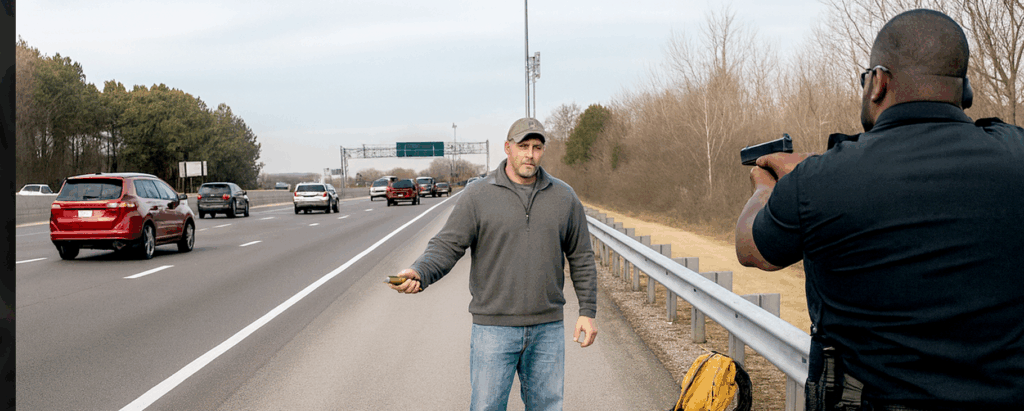Barnes v. Felix, 2025 WL 1401083 (U.S. 2025)
Near Houston, Texas, Deputy Constable Felix stopped Ashtian Barnes for suspected toll violations. During the stop, Barnes claimed he didn’t have a driver’s license with him, and that his girlfriend had rented the car he was driving. While Barnes was explaining this, he was rustling through papers. Deputy Felix had to tell him several times to stop “digging around.” Deputy Felix told Barnes he smelled marijuana, and asked if there was anything in the car he should know about. (Texas state law prohibits recreational cannabis.) Barnes said that he might have some identification in the trunk. Deputy Felix told him to pop the trunk open from inside the car. Barnes shut off the car and activated the trunk release.
Deputy Felix told Barnes to get out of the car. Barnes opened the door but did not get out. Instead, Barnes restarted the vehicle’s ignition. Deputy Felix drew his gun and, as the car began to move forward, jumped onto its doorsill. He twice shouted, “Don’t f&%$ing move.” Deputy Felix fired two shots through the top of the car, fatally wounding Barnes.
Barnes’ estate sued Felix. The trial court granted summary judgment to Felix, leading to an appeal to the 5th Circuit Court of Appeals. The 5th Circuit followed its “moment-of-threat” rule, holding Felix could have reasonably believed he was in danger during the two seconds he was on the doorsill as Barnes was trying to speed away. The 5th Circuit stated it would not consider “what had transpired up until” those last two seconds, including Felix’s decision to jump onto the doorsill.
The 5th Circuit’s “moment-of-threat” rule is “a much narrower approach” than the “totality of the circumstances” doctrine articulated 36 years ago by the Supreme Court in Graham v. Connor (490 U.S. 386 (1989)). My colleague, Chief (Ret.) Mike Ranalli, writes about the “moment-of-threat” rule, laying out the arguments for and against that approach in this excellent article. He also lists the minority of other appellate courts that have followed some form of the “moment-of-threat” rule, illustrating the split among circuits and even within the various panel opinions of a single circuit.
The question presented to the Supreme Court was simple and straightforward, though some would have liked to have thrown more into the mix. Justice Kagan, in the unanimous opinion, writes:
“The question here is whether that framework permits courts, in evaluating a police shooting (or other use of force), to apply the so-called moment-of-threat rule used in the courts below. Under that rule, a court looks only to the circumstances existing at the precise time an officer perceived the threat inducing him to shoot. Today, we reject that approach as improperly narrowing the requisite Fourth Amendment analysis. To assess whether an officer acted reasonably in using force, a court must consider all the relevant circumstances, including facts and events leading up to the climactic moment.”
Justice Kagan sums up the unanimous conclusion: “A court deciding a use-of-force case cannot review the totality of the circumstances if it has put on chronological blinders.”
Some of the parties who submitted amicus briefs to the Court urged discussion of so-called “state-created danger” — sometimes also phrased as “officer-precipitated force” or “officer-created jeopardy.” The Court bluntly refuses to do so: “We do not address here the different question Felix raises about use-of-force cases: whether or how an officer’s own ‘creation of a dangerous situation’ factors into the reasonableness analysis. As in another of our recent Fourth Amendment cases, that issue is not properly before us.” The Court’s unwillingness to consider the ancillary topic of officer-created jeopardy, coupled with Justice Kavanaugh’s concurring opinion (joined by Justices Thomas, Alito and Barrett) suggest the Court is in no hurry to consider that issue — at least not until it is squarely before the Court.
Justice Kavanaugh forcefully reminds readers of Supreme Court statements that traffic stops are “fraught with danger to police officers” (Michigan v. Long, 463 U.S. 1032 (1983)). As the justices point out, an “inordinate risk confront[s] an officer as he approaches a person seated in an automobile … As this Court noted nearly 50 years ago, a significant percentage of murders of police officers occurs when the officers are making traffic stops” (Pennsylvania v. Mimms, 434 U.S. 106 (1977)).
In reaffirming Graham v. Connor’s rule that the reasonableness of police force must be assessed based on the “totality of the circumstances,” the Court reminds us that analysis always includes events leading up to the use of force. The unanimous Court opinion highlights that the “totality of the circumstances” analysis “may benefit either party in an excessive-force case.” As the justices note: “Prior events may show, for example, why a reasonable officer would have perceived otherwise ambiguous conduct of a suspect as threatening. Or instead they may show why such an officer would have perceived the same conduct as innocuous. The history of the interaction, as well as other past circumstances known to the officer, thus may inform the reasonableness of the use of force.”
Those urging the Court to take a broader approach, including adopting a rule about “state-created danger,” argue that the Court had the chance to encourage greater police accountability, and to influence policy and training. Any agency using Lexipol use of force policies knows they are grounded in Graham’s “totality of the circumstances” standard. When we train officers to make force decisions based on the totality of the circumstances known to them, we are promoting accountability and better force decision-making.
At the end of the day, Barnes v. Felix is simply not a watershed decision. It is a reaffirmation of a standard we’ve been policing under for decades — a standard that serves the public and holds officers to an appropriately high expectation when deciding to use force.



